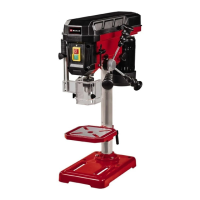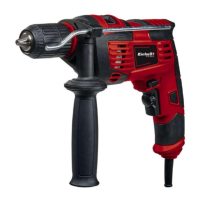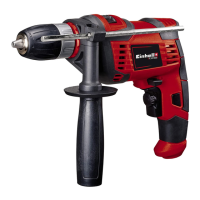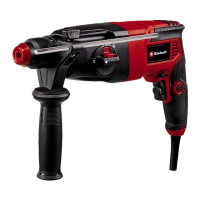- 34 -
12 640 400 560 2400 2000
13 590 370 515 2200 1840
14 545 340 480 2000 1700
16 480 300 420 1800 1500
18 425 265 370 1600 1300
20 380 240 335 1400 1200
22 350 220 305 1300 1100
25 305 190 270 1150 950
6.10 Countersinking and center-drilling
With this drill you can also perform countersin-
king and center-drilling jobs. Please observe that
countersinking should be performed at the lowest
speed, while a high speed is required for center-
drilling.
6.11 Woodworking
Please note that sawdust must be properly eva-
cuated when working with wood, as it can be a
health hazard. Ensure that you wear a suitable
dust mask when performing work that generates
dust.
6.12 Replacing the V-belt (Fig. 12/14-16)
The V-belt of the pillar drill can be replaced if it
becomes worn. Proceed as described in section
6.4 Speed settings.
In this case replace the V-belt (26) instead of re-
positioning it.
7. Replacing the power cable
Danger!
If the power cable for this equipment is damaged,
it must be replaced by the manufacturer or its
authorized after-sales service or similarly trained
personnel to avoid danger.
8. Cleaning, maintenance and
ordering of spare parts
Danger!
Always pull out the mains power plug before star-
ting any cleaning work.
8.1 Cleaning
•
The pillar drill is maintenance-free to a large
extent. Keep the equipment clean. Pull out
the power plug before doing any cleaning and
maintenance work on the equipment. Do not
use any harsh, abrasive solvents for cleaning
purposes. Make sure that no liquid gets into
the equipment. Re-grease all bare parts when
the work is finished. Particularly the drill pillar,
blank parts of the column, and the drill table
should be re-greased at regular intervals. Use
a standard, acid-free lubricating grease for
this purpose.
•
Note: Do not dispose of oil-soaked rags,
grease-soaked rags, oil residues and grease
residues in your household rubbish. Dispose
of such materials in an environment-friendly
way. Check and clean the ventilation holes
regularly. Store the equipment in a dry room.
If the equipment becomes damaged, do not
try to repair it yourself. Leave such repairs to a
qualified electrician.
•
We recommend that you clean the device
immediately each time you have finished
using it.
•
Clean the equipment regularly with a moist
cloth and some soft soap. Do not use
cleaning agents or solvents; these could at-
tack the plastic parts of the equipment. Ensu-
re that no water can seep into the device. The
ingress of water into an electric tool increases
the risk of an electric shock.
8.2 Maintenance
There are no parts inside the equipment which
require additional maintenance.
8.3 Ordering replacement parts:
Please quote the following data when ordering
replacement parts:
•
Type of machine
•
Article number of the machine
•
Identification number of the machine
•
Replacement part number of the part required
9. Disposal and recycling
The equipment is supplied in packaging to pre-
vent it from being damaged in transit. The raw
materials in this packaging can be reused or
recycled. The equipment and its accessories are
made of various types of material, such as metal
and plastic. Never place defective equipment in
your household refuse. The equipment should
be taken to a suitable collection center for proper
disposal. If you do not know the whereabouts of
such a collection point, you should ask in your
local council oces.
Anl_SA_TC_BD_450_SPK8.indb 34Anl_SA_TC_BD_450_SPK8.indb 34 19.07.2022 13:18:2919.07.2022 13:18:29

